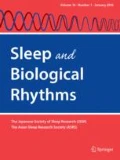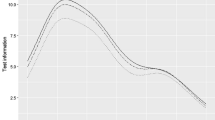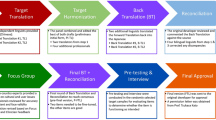Abstract
The Pittsburgh Sleep Quality Index (PSQI) is a widely used measurement tool for assessing sleep disturbance and is broadly used in clinical and healthy populations. Yet, validation of the PSQI has rarely been carried out for a relatively large non-clinical sample in the United States. The aim for the current study is to examine the structure validity of the PSQI. Data from 2189 individuals (mean age 35.88) were analyzed by exploratory factor analysis (EFA) followed by confirmatory factor analysis (CFA). Furthermore, measurement invariance across age groups was examined using multigroup CFA. We found that a three-factor model (i.e., sleep efficiency, sleep latency, and sleep quality) fitted better than the commonly used single-factor structure. Specifically, for the three-factor model, the comparative fit index was 0.99, the Tucker–Lewis fit index was 0.99, and the root-mean-square error of approximation was 0.04. Those fit indices further indicated a good fit between the model and the observed data. Measurement invariance results suggested that the factor structure of PSQI is not comparable for different age groups, which has implications for future research studies. Our findings validated the factor structure of the PSQI on non-clinical populations and recommended the use of three separate factors to assess sleep quality. In addition, the findings demonstrated that different models should be used to assess sleep disturbance across age groups. However, further research is required to determine the appropriate cut-off points for different age groups.

Similar content being viewed by others
References
Stranges S, Tigbe W, Gómez-Olivé FX, Thorogood M, Kandala N-B. Sleep problems: an emerging global epidemic? Findings from the INDEPTH WHO-SAGE Study among more than 40,000 older adults from 8 countries across Africa and Asia. Sleep. 2012;35:1173–81.
Hossain JL, Shapiro CM. The prevalence, cost implications, and management of sleep disorders: an overview. Sleep and Breathing. 2002;6:85–102.
Léger D, Poursain B, Neubauer D, Uchiyama M. An international survey of sleeping problems in the general population. Curr Med Res Opin. 2008;24:307–17.
Buysse DJ, Reynolds CF 3rd, Monk TH, Berman SR, Kupfer DJ. The Pittsburgh Sleep Quality Index: a new instrument for psychiatric practice and research. Psychiatry Res. 1989;28:193–213.
Carpenter JS, Andrykowski MA. Psychometric evaluation of the pittsburgh sleep quality index. J Psychosom Res. 1998;45:5–13.
Åkerstedt T, Hume K, Minors D, Waterhouse J. The subjective meaning of good sleep, an intraindividual approach using the Karolinska Sleep Diary. Percept Mot Skills. 1994;79:287–96.
Snyder-Halpern R, Verran J. Instrumentation to describe subjective sleep characteristics in healthy subjects. Res Nurs Health. 1987;10:155–63.
Buysse DJ, Reynolds CF, Monk TH, Hoch CC, Yeager a L, Kupfer DJ. Quantification of subjective sleep quality in healthy elderly men and women using the Pittsburgh Sleep Quality Index (PSQI). Sleep. 1991;14:331–8.
Gentili A, Werner DK, Kuchibhatla MEJ. Test-retest reliability of the Pittsburgh Sleep Quality Index in nursing home residents. J Am Geriatr Soc. 1995;43:1317–8.
Borbely A. A two process model of sleep regulation. Hum Neurobiol. 1982;1:195–204.
Floyd FJ, Widaman KF. Factor analysis in the development and refinement of clinical assessment instruments. Psychol Assess. 1995;7:286–99.
Mariman A, Vogelaers D, Hanoulle I, Delesie L, Tobback E, Pevernagie D. Validation of the three-factor model of the PSQI in a large sample of chronic fatigue syndrome (CFS) patients. J Psychosom Res. 2012;72:111–3.
Burkhalter H, Sereika SM, Engberg S, Wirz-Justice A, Steiger J, De Geest S. Structure validity of the Pittsburgh Sleep Quality Index in renal transplant recipients: A confirmatory factor analysis. Sleep Biol Rhythms. 2010;8:274–81.
Cole JC, Motivala SJ, Buysse DJ, Oxman MN, Levin MJ, Irwin MR. Validation of a 3-factor scoring model for the Pittsburgh sleep quality index in older adults. Sleep. 2006;29:112–6.
Magee C, Caputi P, Iverson DC, Huang X-F. An investigation of the dimensionality of the Pittsburgh Sleep Quality Index in Australian adults. Sleep Biol Rhythms. 2008;6:222–7.
Tomfohr LM, Schweizer CA, Dimsdale JE, Loredo JS. Psychometric characteristics of the pittsburgh sleep quality index in english speaking non-hispanic whites and english and spanish speaking hispanics of mexican descent. J Clin Sleep Med. 2013;9:61–6.
Hita-Contreras F, Martínez-López E, Latorre-Román PA, Garrido F, Santos MA, Martínez-Amat A. Reliability and validity of the Spanish version of the Pittsburgh Sleep Quality Index (PSQI) in patients with fibromyalgia. Rheumatol Int. 2014;34:929–36.
Nicassio PM, Ormseth SR, Custodio MK, Olmstead R, Weisman MH, Irwin MR. Confirmatory factor analysis of the Pittsburgh Sleep Quality Index in rheumatoid arthritis patients. Behav Sleep Med. 2014;12:1–12.
Otte JL, Rand KL, Carpenter JS, Russell KM, Champion VL. Factor analysis of the pittsburgh sleep quality index in breast cancer survivors. J Pain Symptom Manage. 2013;45:620–7.
Maurice M, Ohayon MA, Carskadon C, Guilleminault MV, Vitiello. Meta-analysis of quantitative sleep parameters from childhood to old age in healthy individuals: developing normative sleep values across the human lifespan. Sleep. 2004;27:1255–73.
Roepke SK, Ancoli-Israel S. Sleep disorders in the elderly. Indian J Med Res. 2010;131:302–10.
Manzar MD, BaHammam AS, Hameed UA, Spence DW, Pandi-Perumal SR, Moscovitch A, et al. Dimensionality of the Pittsburgh Sleep Quality Index: A systematic review. Health Qual Life Outcomes. 2018;16:89
Buhrmester M, Kwang T, Gosling SD. Amazon’s Mechanical Turk: a new source of inexpensive, yet high-quality, data? Perspect Psychol Sci. 2011;6:3–5.
Beavers AS, Lounsbury JW, Richards JK, Huck SW, Skolits GJ, Esquivel SL. Practical considerations for using exploratory factor analysis in educational research. Pract Assess Res Eval. 2013;18:1–13.
Williams B, Onsman A, Brown T. EDUCATION. Exploratory factor analysis: A five-step guide for novices. Australas J Paramed J Emerg Prim Health Care. 2012;8(3):990399.
Paolacci G, Chandler J. Inside the turk: understanding mechanical turk as a participant pool. Curr Dir Psychol Sci. 2014;23:184–8.
Casler K, Bickel L, Hackett E. Separate but equal? A comparison of participants and data gathered via Amazon’s MTurk, social media, and face-to-face behavioral testing. Comput Human Behav. 2013;29:2156–60.
Gardner RM, Brown DL, Boice R. Using Amazon’s Mechanical Turk website to measure accuracy of body size estimation and body dissatisfaction. Body Image. 2012;9:532–4.
StataCorp. Stata Statistical Software: Release 15. 2017. 2017.
Muthén L, Muthén B. Mplus user’s guide, version 7.2. Los Angeles Author. 2012.
Cohen J. Statistical power analysis for the behavioral sciences. Hilsdale: Lawrence Erlbaum Associates; 1988. p. 567.
Anderson J, Gerbing D. Structural equation modeling in practice: a review and recommended two-step approach. Psychol Bull. 1988;103:411–23.
Guo S, Sun W, Liu C, Wu S. Structural validity of the Pittsburgh sleep quality index in Chinese undergraduate students. Front Psychol. 2016;7:1126.
Besnoy KD, Dantzler J, Besnoy LR, Byrne C. Using exploratory and confirmatory factor analysis to measure construct validity of the Traits, Aptitudes, and Behaviors Scale (TABS). J Educ Gift. 2016;39:3–22.
Monk TH, Reynolds CF, Buysse DJ, DeGrazia JM, Kupfer DJ. The relationship between lifestyle regularity and subjective sleep quality. Chronobiol Int. 2003;20:97–107.
Preacher KJ, MacCallum RC. Repairing Tom Swift’s electric factor analysis machine. Underst Stat. 2003;2:13–43.
Conway JM, Huffcutt AI. A review and evaluation of exploratory factor analysis practices in organizational research. Organ Res Methods. 2003;6:147–68.
Thurstone LL. The vectors of mind. Psychol Rev. 1934;41:1–32.
Thurstone LL. Multiple factor analysis. Psychol Rev. 1931;38:406–27.
Schmitt TA, Sass DA. Rotation criteria and hypothesis testing for exploratory factor analysis: Implications for factor pattern loadings and interfactor correlations. Educ Psychol Meas. 2011;71:95–113.
Browne MW, Cudeck R. Alternative ways of assessing model fit. Sociol Methods Res. 1992;21:230–58.
Kline RB. Principles and practice of structural equation modeling. Vol. 156. New York: Guilford Publications; 2011. p. 427.
Bollen KA, Stine RA. Bootstrapping goodness-of-fit measures in structural equation models. Sociol Methods Res. 1992;21:205–29.
Vandenberg RJ, Lance CE. A review and synthesis of the measurement invariance literature: suggestions, practices, and recommendations for organizational research. Organ Res Methods. 2000;3:4–70.
Horn JL, McArdle JJ, Mason R. When is invariance not invarient: a practical scientist’s look at the ethereal concept of factor invariance. South Psychol. 1983;1:179–88.
Rock DA, Werts CE, Flaugher RL. The use of analysis of covariance structures for comparing the psychometric properties of multiple variables across populations. Multivar Behav Res. 1987;13:403–18.
Marsh HW. Confirmatory factor analysis models of factorial invariance: a multifaceted approach. Struct Equ Model A Multidiscip J. 1994;1:5–34.
Satorra A, Bentler P. Scaling corrections for statistics in covariance structure analysis. Department of Statistics, UCLA; 2011.
Steiger JH. Structural model evaluation and modification: an interval estimation approach. Multivar Behav Res. 1990;25:173–80.
Satorra A, Bentler P. A scaled difference chi-square test statistic for moment structure analysis. Psychometrika. 2000;66:507–14.
Cheung GW, Rensvold RB. Evaluating goodness-of-fit indexes for testing measurement invariance. Struct Equ Model A Multidiscip J. 2002;9:233–55.
Müller MJ, Olschinski C, Kundermann B, Cabanel N. Subjective sleep quality and sleep duration of patients in a psychiatric hospital. Sleep Sci. 2016;9:202–6.
Manzar MD, Zannat W, Moiz JA, Spence DW, Pandi-Perumal SR, Bahammam AS, et al. Factor scoring models of the Pittsburgh Sleep Quality Index: a comparative confirmatory factor analysis. Biol Rhythm Res. 2016;47:851–64.
Otte JL, Rand KL, Landis CA, Paudel ML, Newton KM, Woods N, et al. Confirmatory factor analysis of the Pittsburgh Sleep Quality Index in women with hot flashes. Menopause. 2015;22:1190–6.
Terwee CB, Jansma EP, Riphagen II, De Vet HCW. Development of a methodological PubMed search filter for finding studies on measurement properties of measurement instruments. Qual Life Res. 2009;18:1115–23.
Department of Economic and Social Affairs PD. Population of the United States. World Population Prospect: 2017 Revision 21 2017.
Acknowledgements
The authors would like to acknowledge the financial support awarded by the 2015 Catapult grants rounds provided by the College of Education and Human Development at Texas A&M University.
Author information
Authors and Affiliations
Corresponding author
Ethics declarations
Conflict of interest
All authors declare no conflict of interest.
Ethical approval
All procedures performed in studies involving human participants were in accordance with the ethical standards of the institutional and/or national research committee and with the 1964 Helsinki declaration and its later amendments or comparable ethical standards. Informed consent was obtained from all the individuals. The study was approved by the Institutional Review Board (IRB) at Texas A&M University (IRB2016-0441D).
Electronic supplementary material
Below is the link to the electronic supplementary material.
Rights and permissions
About this article
Cite this article
Jia, Y., Chen, S., Deutz, N.E.P. et al. Examining the structure validity of the Pittsburgh Sleep Quality Index. Sleep Biol. Rhythms 17, 209–221 (2019). https://doi.org/10.1007/s41105-018-00201-0
Received:
Accepted:
Published:
Issue Date:
DOI: https://doi.org/10.1007/s41105-018-00201-0




